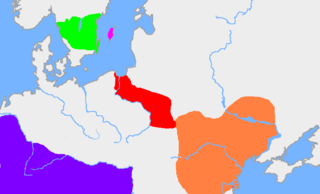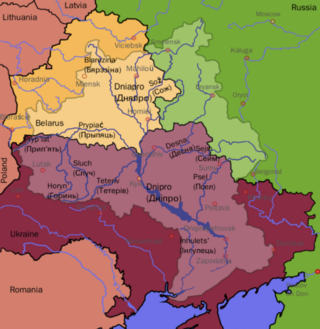
The Baltic languages are a branch of the Indo-European language family spoken natively or as a second language by a population of about 6.5–7.0 million people mainly in areas extending east and southeast of the Baltic Sea in Europe. Together with the Slavic languages, they form the Balto-Slavic branch of the Indo-European family.
The Slavs or Slavic peoples are the most populous European ethnolinguistic group. They speak the various Slavic languages, belonging to the larger Balto-Slavic branch of the Indo-European language family. Slavs are geographically distributed throughout the northern parts of Eurasia; they predominantly inhabit Central Europe, Eastern Europe, and Southeastern Europe, though there is a large Slavic minority scattered across the Baltics, Northern Asia, and Central Asia. Continued immigration has resulted in the development of a substantial Slavic diaspora in the Americas.

Wends is a historical name for Slavs who inhabited present day north east Germany. It refers not to a homogeneous people, but to various peoples, tribes or groups depending on where and when it was used. In the modern day, communities identifying as Wendish exist in Slovenia, Austria, Lusatia, the United States, and Australia.

The East Slavs are the most populous subgroup of the Slavs. They speak the East Slavic languages, and formed the majority of the population of the medieval state Kievan Rus', which they claim as their cultural ancestor. Today, the East Slavs consist of Belarusians, Russians, Rusyns, and Ukrainians.

The Volga is the longest river in Europe. Situated in Russia, it flows through Central Russia to Southern Russia and into the Caspian Sea. The Volga has a length of 3,531 km (2,194 mi), and a catchment area of 1,360,000 km2 (530,000 sq mi). It is also Europe's largest river in terms of average discharge at delta – between 8,000 m3/s (280,000 cu ft/s) and 8,500 m3/s (300,000 cu ft/s) – and of drainage basin. It is widely regarded as the national river of Russia. The hypothetical old Russian state, the Rus' Khaganate, arose along the Volga c. 830 AD. Historically, the river served as an important meeting place of various Eurasian civilizations.
Ruthenia is an exonym, originally used in Medieval Latin, as one of several terms for Kievan Rus'. It is also used to refer to the East Slavic and Eastern Orthodox regions of the Grand Duchy of Lithuania and the Kingdom of Poland, and later the Polish-Lithuanian Commonwealth, corresponding to what is now Belarus and Ukraine. Historically, the term was used to refer to all the territories of the East Slavs.

Slavic mythology or Slavic paganism is the religious beliefs, myths, and ritual practices of the Slavs before Christianisation, which occurred at various stages between the 8th and the 13th century. The South Slavs, who likely settled in the Balkan Peninsula during the 6th–7th centuries AD, bordering with the Byzantine Empire to the south, came under the sphere of influence of Eastern Christianity, beginning with the creation of writing systems for Slavic languages in 855 by the brothers Saints Cyril and Methodius and the adoption of Christianity in Bulgaria in 864 and 863 in Great Moravia. The East Slavs followed with the official adoption in 988 by Vladimir the Great of Kievan Rus'.
The Vistula Veneti, also called Baltic Veneti were an Indo-European peoples that inhabited the lands of central Europe east of the Vistula River and the Bay of Gdańsk. First mentioned in the 1st century AD by ancient Roman geographers who differentiated a group of peoples whose manner and language differed from that of the neighbouring Germanic and Sarmatian tribes. In the 6th century AD, Byzantine historians described the Veneti as the ancestors of the Slavs who during the second phase of the Migration Period crossed the northern frontiers of the Byzantine Empire.

The Wielbark culture is an Iron Age archaeological complex which flourished on the territory of today's Poland from the 1st century AD to the 5th century AD.

The Chernyakhov culture, Cherniakhiv culture or Sântana de Mureș—Chernyakhov culture was an archaeological culture that flourished between the 2nd and 5th centuries CE in a wide area of Eastern Europe, specifically in what is now Ukraine, Romania, Moldova and parts of Belarus. The culture is thought to be the result of a multiethnic cultural mix of the Geto-Dacian, Sarmatian, and Gothic populations of the area. "In the past, the association of this [Chernyakhov] culture with the Goths was highly contentious, but important methodological advances have made it irresistible."

The prehistory and protohistory of Poland can be traced from the first appearance of Homo species on the territory of modern-day Poland, to the establishment of the Polish state in the 10th century AD, a span of roughly 500,000 years.

Galindians were two distinct, and now extinct, tribes of the Balts. Most commonly, Galindians refers to the Western Galindians who lived in the southeast part of Prussia. Less commonly, it is used for a tribe that lived in the area of what is today Moscow.

The Dnieper Balts were a subgroup of the Balts that lived in the Dnieper river basin for millennia until the Late Middle Ages, when they were partly destroyed and partly assimilated by the Slavs by the 13th century. To the north and northeast of the Dnieper Balts were the Volga Finns, and to the southeast and south were the ancient Iranians, the Scythians.
The linguistic classification of the ancient Thracian language has long been a matter of contention and uncertainty, and there are widely varying hypotheses regarding its position among other Paleo-Balkan languages. It is not contested, however, that the Thracian languages were Indo-European languages which had acquired satem characteristics by the time they are attested.

The most important phenomenon that took place within the lands of Poland in the Early Middle Ages, as well as other parts of Central Europe was the arrival and permanent settlement of the West Slavic or Lechitic peoples. The Slavic migrations to the area of contemporary Poland started in the second half of the 5th century AD, about a half century after these territories were vacated by Germanic tribes fleeing from the Huns. The first waves of the incoming Slavs settled the vicinity of the upper Vistula River and elsewhere in the lands of present southeastern Poland and southern Masovia. Coming from the east, from the upper and middle regions of the Dnieper River, the immigrants would have had come primarily from the western branch of the early Slavs known as Sclaveni, and since their arrival are classified as West Slavs and Lechites, who are the closest ancestors of Poles.

The Volga Finns are a historical group of indigenous peoples of Russia living in the vicinity of the Volga, who speak Uralic languages. Their modern representatives are the Mari people, the Erzya and the Moksha Mordvins, as well as speakers of the extinct Merya, Muromian and Meshchera languages. The Permians are sometimes also grouped as Volga Finns.

The early Slavs were an Indo-European peoples who lived during the Migration Period and the Early Middle Ages in Central and Eastern Europe and established the foundations for the Slavic nations through the Slavic states of the High Middle Ages. The Slavs' original homeland is still a matter of debate due to a lack of historical records; however, scholars believe that it was in Eastern Europe, with Polesia being the most commonly accepted location.

The Penkovka culture is an archaeological culture in Ukraine, Moldova and reaching into Romania. Its western boundary is usually taken to at the middle Prut and Dniester rivers, where contact with the Korchak culture occurs. Its bearers are commonly identified as the Antes people of 6th-century Byzantine historiography.

Volyntsevo culture is an archaeological culture of the early Middle Ages, located between the Dnieper and the Don rivers. In the west, the territory of the Volyntsevo monuments reaches the right bank of Dnieper in the Kyiv area. Dmitry Berezovets identified the culture, and named it after the village of Volyntseve in Sumy Oblast of Central Ukraine, which he excavated in 1948–1950.














